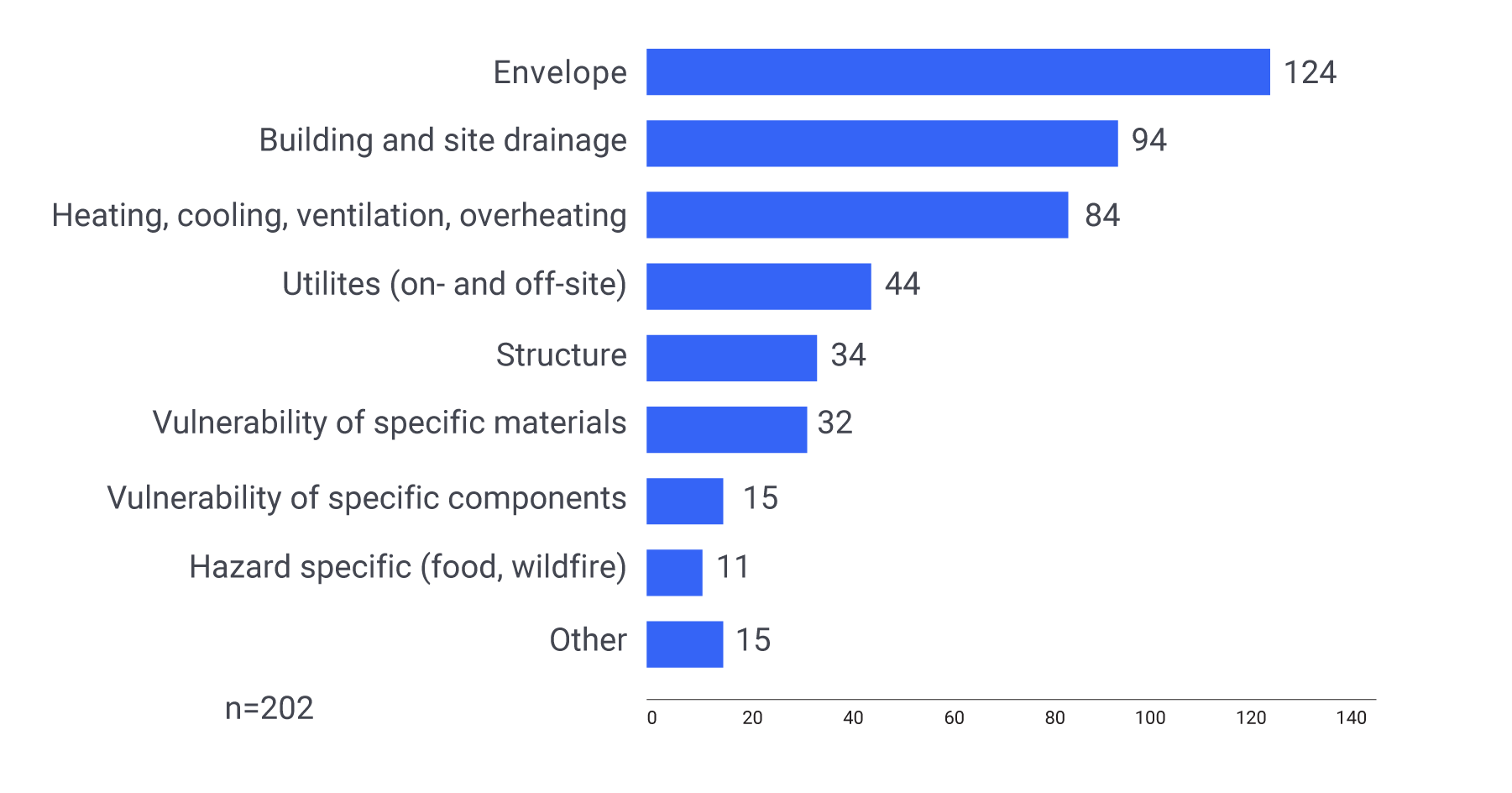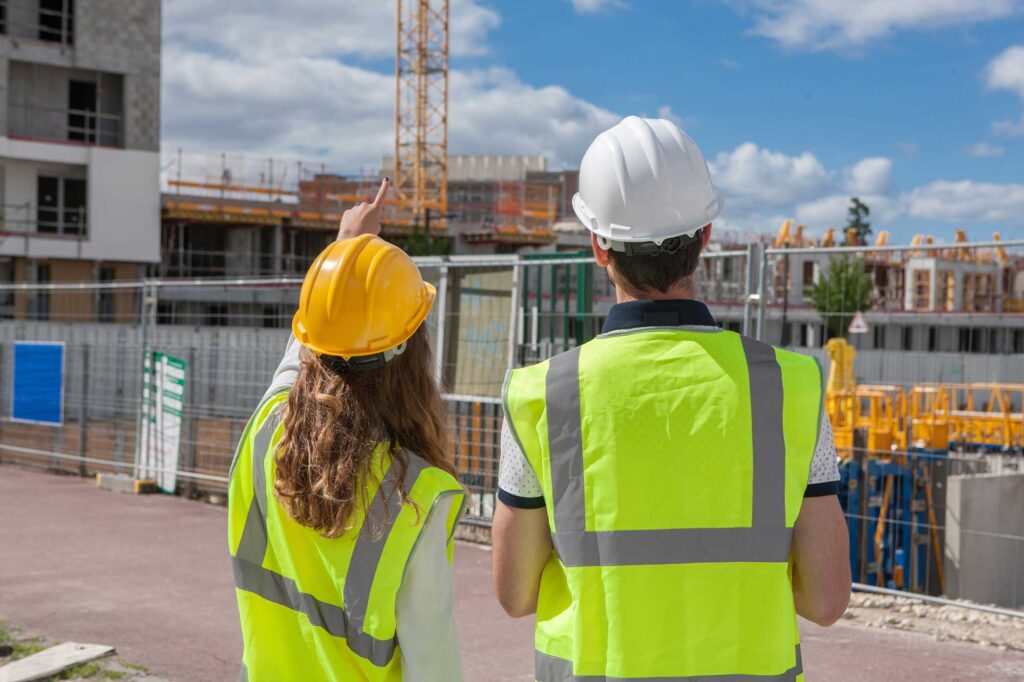Building Resilience and Climate Change in Canada
In support of ClimateData.ca’s Buildings Module, the Institute for Catastrophic Loss Reduction (ICLR) was commissioned to explore the state of climate change considerations in Canada’s building sector.
A pair of surveys, conducted in the latter half of 2020, were disseminated to a wide range of professionals within the building industry. Respondent groups spanned federal, provincial, territorial, and local governments, and included federal agencies, Crown corporations, industry, insurers, non-governmental organizations, and academia.
The results of the surveys were quite clear. Over 80% of building professionals surveyed believe that climate change should be used to inform work in their sector, for both new and existing buildings. Similarly, most respondents believed that they should not wait until climate change is incorporated into official codes and standards before taking action.
Respondents highlighted that many building components and systems, including building envelopes, site drainage, and heating, ventilation, and air conditioning systems (HVAC), are potentially affected by changes in climate, and that these vulnerabilities need to be addressed in order for buildings to remain safe and functional (Figure 1).
Reflecting these concerns, an ecosystem of national climate change-specific guidelines, standards, data and codes, funding, and networks are fast emerging.
The 2016 Pan-Canadian Framework on Clean Growth and Climate Change has helped spur recent progress, as it highlights that “climate-related infrastructure failures can threaten health and safety, interrupt essential services, disrupt economic activity, and incur high costs for recovery and replacement,” and that “integrat[ing] climate resilience into building design guides and codes” is vital for ensuring the standardized consideration of future climate hazards in building design and retrofit.
In support of the Framework and its goals, the National Research Council launched a major program in 2016 (funded by Infrastructure Canada), titled the Climate-Resilient Buildings and Core Public Infrastructure (CRBCPI) Initiative. Five years later, the CRBCPI Initiative and broader Framework have yielded a range of pioneering new guidelines, including:
A 2020 CRBCPI report is Canada’s most detailed foray yet into providing building-specific climate change metrics. These data are being considered for adoption in the 2025 National Building Code, and are powering tools like the new climate resilience for low slope membrane roofing systems application.
Federal funding for climate-resilient buildings supports the application of new climate-aware standards, data, and codes to real world building design and retrofit. Via the federal Climate Lens and related initiatives, Infrastructure Canada is working to ensure that new major infrastructure projects initiated under funding opportunities like the Disaster Mitigation and Adaptation Fund and Green and Inclusive Community Buildings program include robust assessments of present and future climate risks, informed by national networks of communities of practice such as the Infrastructure and Buildings Working Group under Canada’s Adaptation Platform.
Provinces and territories are showing leadership in the area of climate resilient building planning and design. Examples include Ontario, which in 2016 tasked its Minister of Municipal Affairs with “…a review of the Building Code to support low-carbon standards for new buildings and to ensure that buildings continue to be safe and accessible,” and Quebec, which stated the need to “collaborate in the development of criteria, codes, guides, and other tools necessary for adapting the built environment to climate change,” in a 2013-2020 Government Strategy for Climate Change Adaptation. Provincial and territorial bodies can set a tone for change, which can spur innovative thinking. In British Columbia, for example, BC Housing’s Mobilizing Building Adaptation and Resilience project is supporting capacity building and innovation in resilient, low-carbon building design. Quebec’s Société québecoise des infrastructure (SQI) is identifying climate risks and climate adaptation measures for its institutional building stock through the use of their new assessment framework, which may be adapted for use by other interested property owners and managers.
Municipalities are uniquely positioned to accelerate climate resilience in the buildings sector, as they integrate climate change-related provisions through zoning and planning, local construction requirements, guidelines, and programs, and also provide provincial code interpretations that target regional building vulnerabilities. In many cases, existing planning pathways and governance structures (for example, disaster response and recovery) can be effectively leveraged to enable excellent, vulnerability-motivated or ‘bottom-up’ climate adaptation actions that directly address known vulnerabilities.
Where there are gaps in provincial codes, local jurisdictions have applied other regulatory tools at their disposal to reduce building vulnerability. This allows for climate considerations to be included at a local level that are tailored to unique interactions between local buildings and local climate. Increasingly, integration of future climate information into these municipal-level building and planning efforts is occurring via municipal Climate Action Plans. At the national level, the Federation of Canadian Municipalities is an important foundation for enhancing capacity and knowledge-sharing between municipalities.
On the financial impacts side, several bodies, such as the Institute for Catastrophic Loss Reduction and the Insurance Bureau of Canada, are considering how to manage climate change impacts to building insurance and property value trends. The Intact Centre on Climate Adaptation was established by the Intact Financial Corporation (the largest provider of property and casualty insurance in Canada), to identify and reduce risks to buildings and infrastructure from the negative impacts of a changing climate. Finally, long-term lenders to many building projects are increasingly requiring that climate risk be included in financial risk statements, via frameworks such as the Task Force on Climate-related Financial Disclosures guidance.
The importance of adapting buildings to future climate change is also recognized on the international stage. For example, the Global Alliance for Buildings and Construction (GlobalABC) has recently produced the first output of the GlobalABC Adaptation Working Group (launched at the 24th Conference of the Parties – COP24). Their 2020 report details the challenges and benefits of climate change adaptation in the building and construction sectors, and provides suggested actions for a variety of stakeholder groups.
It is clear that expectations and opportunities for practitioners to integrate resilience to climate change in Canada’s buildings sector are growing. Together with ongoing efforts to curtail greenhouse gas emissions from the sector, these efforts should ensure that our buildings contribute to the overall sustainability and safety of communities across the country.




